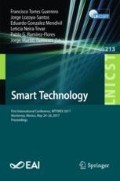Abstract
In recent years, the increasing number of wearable sensors by humans can serve for many purposes like emergency care, health care remote monitoring, personal entertainment and communication. In the case of health care applications, wearable sensors enable long-term continuous physiological monitoring without disturbing day to day activities, which is important for the treatment and management of many chronic illnesses, neurological disorders, and mental health issues. Examples include: diabetes, autism spectrum disorder (ASD), depression, drug addiction, and anxiety disorders. In general, wearable sensors can be used individually or as networked systems. In any case, sensors communication and authentication are key aspects in the deployment of these systems. A Wireless Body Area Network (WBAN) is created by wearing small sensors on the human body. To ensure authentication in on-body sensor networks, a mechanism which intuitively proves that all the communicating nodes are trusted ones is required. In order to achieve sensor authentication, in this paper a technological approach where accelerometer data gathered from sensors are used to distinguish whether or not the devices are carried on the same individual’s body, is presented. This system detects this situation by calculating the correlations between embedded accelerometers in a cellphone and accelerometer sensors. We evaluate our method over a dataset of fifteen wearers with sensors in various positions on their body.
Access this chapter
Tax calculation will be finalised at checkout
Purchases are for personal use only
References
Cherukuri, S., Venkatasubramanian, K., Gupta, S.: Biosec: a biometric based approach for securing communication in wireless networks of biosensors implanted in the human body. In: Proceedings 2003 International Conference on Parallel Processing Workshops, pp. 432–439, October 2003
Timm, K.: Medical device hacking prompts concern, August 2011. http://www.cyberprivacynews.com/2011/08/medicaldevice-hacking-prompts-concern/
Zeng, K., Govindan, K., Mohapatra, P.: Non-cryptographic authentication and identification in wireless networks. Wireless Commun. 17, 56–62 (2010)
Chan, H., Perrig, A., Song, D.: Random key predistribution schemes for sensor networks. In: IEEE S&P 2003, p. 197, Proceedings of the 1st ACM workshop on Security of ad hoc and sensor networks, pp. 62–71. ACM (2003)
Du, W., Deng, J., Han, Y., Varshney, P., Katz, J., Khalili, A.: A pairwise key predistribution scheme for wireless sensor networks. ACM Trans. Inf. Syst. Secur. (TISSEC) 8(2), 228–258 (2005)
Tan, C.C., Wang, H., Zhong, S., Li, Q.: Body sensor network security: an identity-based cryptography approach. In: ACM WiSec 2008, pp. 148–153 (2008)
Szczechowiak, P., Oliveira, L.B., Scott, M., Collier, M., Dahab, R.: NanoECC: testing the limits of elliptic curve cryptography in sensor networks. In: Proceedings of the 5th European Conference on Wireless Sensor Networks, Bologna, Italy, pp. 305–320, February 2008
Venkatasubramanian, K., Gupta, S.: Physiological value-based efficient usable security solutions for body sensor networks. ACM Trans. Sens. Netw. (TOSN) 6(4), 1–36 (2010)
Venkatasubramanian, K.K., Gupta, S.K.S.: Physiological value-based efficient usable security solutions for body sensor networks. ACM Trans. Sen. Netw. 6, 31:1–31:36 (2010)
Xu, F., Qin, Z., Tan, C., Wang, B., Li, Q.: IMDGuard: securing implantable medical devices with the external wearable guardian. In: The 30th IEEE International Conference on Computer Communications (INFOCOM 2011), Shanghai, P.R. China, pp. 1862–1870, April 2011
Varshavsky, A., Scannell, A., LaMarca, A., de Lara, E.: Amigo: proximity-based authentication of mobile devices. In: Krumm, J., Abowd, G.D., Seneviratne, A., Strang, T. (eds.) UbiComp 2007. LNCS, vol. 4717, pp. 253–270. Springer, Heidelberg (2007). https://doi.org/10.1007/978-3-540-74853-3_15
Shi, L., Li, M., Yu, S., Yuan, J.: BANA: body area network authentication exploiting channel characteristics. In: Proceedings of the Fifth ACM Conference on Security and Privacy in Wireless and Mobile Networks, 16–18 April 2012, Tucson, Arizona, USA (2012)
Cai, L., Zeng, K., Chen, H., Mohapatra, P.: Good neighbor: ad hoc pairing of nearby wireless devices by multiple antennas. In: Network and Distributed System Security Symposium (2011)
Patwari, N., Kasera, S.: Robust location distinction using temporal link signatures. In: Proceedings of the 13th Annual ACM International Conference on Mobile Computing and Networking, pp. 111–122. ACM (2007)
Ben-Pazi, H., Bergman, H., Goldberg, J.A., Giladi, N., Hansel, D., Reches, A., Simon, E.S.: Synchrony of rest tremor in multiple limbs in Parkinson’s disease: evidence for multiple oscillators. J. Neural Transm. 108(3), 287–296 (2001)
Chen, M., Gonzalez, S., Vasilakos, A., Cao, H., Leung, V.C.: Body area networks: a survey. Mob. Netw. Appl. 16, 171–193 (2011)
llah, S., Higgins, H., Braem, B., Latre, B., Blondia, C., Moerman, I., Saleem, S., Rahman, Z., Kwak, K.: A comprehensive survey of wireless body area networks. J. Med. Syst. 36(3), 1065–1094 (2010)
Karlof, C., Sastry, N., Wagner, D.: TinySec: a link layer security architecture for wireless sensor networks. In: Proceedings of the 2nd International Conference on Embedded Networked Sensor Systems, (SenSys 2004), Baltimore, Md, USA, pp. 162–175, November 2004
Roggen, D., et al.: Collecting complex activity datasets in highly rich networked sensor environments. In: 2010 Seventh International Conference on Networked Sensing Systems (INSS), Kassel, pp. 233–240 (2010). https://doi.org/10.1109/inss.2010.5573462
Shi, L., Yuan, J., Yu, S., Li, M.: ASK-BAN: authenticated secret key extraction utilizing channel characteristics for body area networks. In: Proceedings 6th ACM Conference on Security and Privacy in Wireless and Mobile Networks (WiSec 2013), pp. 155–166 (2013)
Cornelius, C.T., Kotz, D.F.: Recognizing whether sensors are on the same body. Pervasive Mob. Comput. 8(6), 822–836 (2012)
Author information
Authors and Affiliations
Corresponding author
Editor information
Editors and Affiliations
Rights and permissions
Copyright information
© 2018 ICST Institute for Computer Sciences, Social Informatics and Telecommunications Engineering
About this paper
Cite this paper
Elyazidi, S., Escamilla-Ambrosio, P.J., Gallegos-Garcia, G., Rodríguez-Mota, A. (2018). Accelerometer Based Body Area Network Sensor Authentication. In: Torres Guerrero, F., Lozoya-Santos, J., Gonzalez Mendivil, E., Neira-Tovar, L., Ramírez Flores, P., Martin-Gutierrez, J. (eds) Smart Technology. Lecture Notes of the Institute for Computer Sciences, Social Informatics and Telecommunications Engineering, vol 213. Springer, Cham. https://doi.org/10.1007/978-3-319-73323-4_15
Download citation
DOI: https://doi.org/10.1007/978-3-319-73323-4_15
Published:
Publisher Name: Springer, Cham
Print ISBN: 978-3-319-73322-7
Online ISBN: 978-3-319-73323-4
eBook Packages: Computer ScienceComputer Science (R0)

